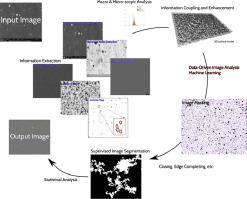当前位置:
X-MOL 学术
›
Ultramicroscopy
›
论文详情
Our official English website, www.x-mol.net, welcomes your
feedback! (Note: you will need to create a separate account there.)
Auto-Segmentation Technique for SEM Images Using Machine Learning: Asphaltene Deposition Case Study
Ultramicroscopy ( IF 2.1 ) Pub Date : 2020-10-01 , DOI: 10.1016/j.ultramic.2020.113074 Masakazu Gesho 1 , Wattana Chaisoontornyotin 1 , Omar Elkhatib 1 , Lamia Goual 1
Ultramicroscopy ( IF 2.1 ) Pub Date : 2020-10-01 , DOI: 10.1016/j.ultramic.2020.113074 Masakazu Gesho 1 , Wattana Chaisoontornyotin 1 , Omar Elkhatib 1 , Lamia Goual 1
Affiliation

|
Enormous efforts have been attempted to replace the subjective human analysis of digital images by automated computational methods such as image processing and computer vision. The image processing methods (i.e., pixel- and object-based assessments) determine a variety of spectral/optical features and devices/data properties on the images so that appropriate information could be extracted. However, these methods may not be appropriate when globally heterogeneous and locally anisotropic features exist such as those found in Scanning Electron Microscopy (SEM) Images. Thus, it is essential to have an adaptive and data-driven procedure to extract optimal information from individual SEM images. In this study, we developed a fully automated image processing and analysis method using data analytics, pattern recognition, and machine learning (including deep learning) techniques to automate the image processing and investigate physical properties and nanoscale deposition of petroleum constituents such as asphaltenes on surfaces from over hundreds of images. To do so, various data preparation processes (i.e., image filtering and quality assessment methods) were first introduced to mine and enhance the data. Then, the extracted information was used to identify and quantify targeted physical properties and deposition attributes by denosing and image segmentation techniques. To validate the proposed method, we applied the model to the experimental results from asphaltene deposition studies. The model results were then compared with the corresponding experimental counterparts from the literature. The insight from this application led to a better understanding of the asphaltene deposition mechanism. To the best of our knowledge, this work is one of the first attempts to develop a fully automated image-processing model that describes physical properties of deposited species. In addition, our combination of data and descriptive models allowed us to differentiate foreground and background information particles from SEM images meaning that the model could be used for other applications in image processing.
中文翻译:

使用机器学习的 SEM 图像自动分割技术:沥青质沉积案例研究
已经做出了巨大的努力,以通过诸如图像处理和计算机视觉之类的自动计算方法来取代对数字图像的主观人工分析。图像处理方法(即基于像素和基于对象的评估)确定图像上的各种光谱/光学特征和设备/数据属性,以便可以提取适当的信息。然而,当存在全局异质和局部各向异性特征时,这些方法可能不合适,例如在扫描电子显微镜 (SEM) 图像中发现的特征。因此,必须有一个自适应和数据驱动的程序来从单个 SEM 图像中提取最佳信息。在这项研究中,我们使用数据分析、模式识别、和机器学习(包括深度学习)技术来自动化图像处理,并从数百张图像中研究石油成分(如沥青质)在表面的物理特性和纳米级沉积。为此,首先引入了各种数据准备过程(即图像过滤和质量评估方法)来挖掘和增强数据。然后,通过去噪和图像分割技术,提取的信息用于识别和量化目标物理特性和沉积属性。为了验证所提出的方法,我们将该模型应用于沥青质沉积研究的实验结果。然后将模型结果与文献中相应的实验对应物进行比较。从这个应用中获得的见解有助于更好地了解沥青质沉积机制。据我们所知,这项工作是首次尝试开发描述沉积物种物理特性的全自动图像处理模型。此外,我们的数据和描述性模型的组合使我们能够从 SEM 图像中区分前景和背景信息粒子,这意味着该模型可用于图像处理中的其他应用。
更新日期:2020-10-01
中文翻译:

使用机器学习的 SEM 图像自动分割技术:沥青质沉积案例研究
已经做出了巨大的努力,以通过诸如图像处理和计算机视觉之类的自动计算方法来取代对数字图像的主观人工分析。图像处理方法(即基于像素和基于对象的评估)确定图像上的各种光谱/光学特征和设备/数据属性,以便可以提取适当的信息。然而,当存在全局异质和局部各向异性特征时,这些方法可能不合适,例如在扫描电子显微镜 (SEM) 图像中发现的特征。因此,必须有一个自适应和数据驱动的程序来从单个 SEM 图像中提取最佳信息。在这项研究中,我们使用数据分析、模式识别、和机器学习(包括深度学习)技术来自动化图像处理,并从数百张图像中研究石油成分(如沥青质)在表面的物理特性和纳米级沉积。为此,首先引入了各种数据准备过程(即图像过滤和质量评估方法)来挖掘和增强数据。然后,通过去噪和图像分割技术,提取的信息用于识别和量化目标物理特性和沉积属性。为了验证所提出的方法,我们将该模型应用于沥青质沉积研究的实验结果。然后将模型结果与文献中相应的实验对应物进行比较。从这个应用中获得的见解有助于更好地了解沥青质沉积机制。据我们所知,这项工作是首次尝试开发描述沉积物种物理特性的全自动图像处理模型。此外,我们的数据和描述性模型的组合使我们能够从 SEM 图像中区分前景和背景信息粒子,这意味着该模型可用于图像处理中的其他应用。











































 京公网安备 11010802027423号
京公网安备 11010802027423号